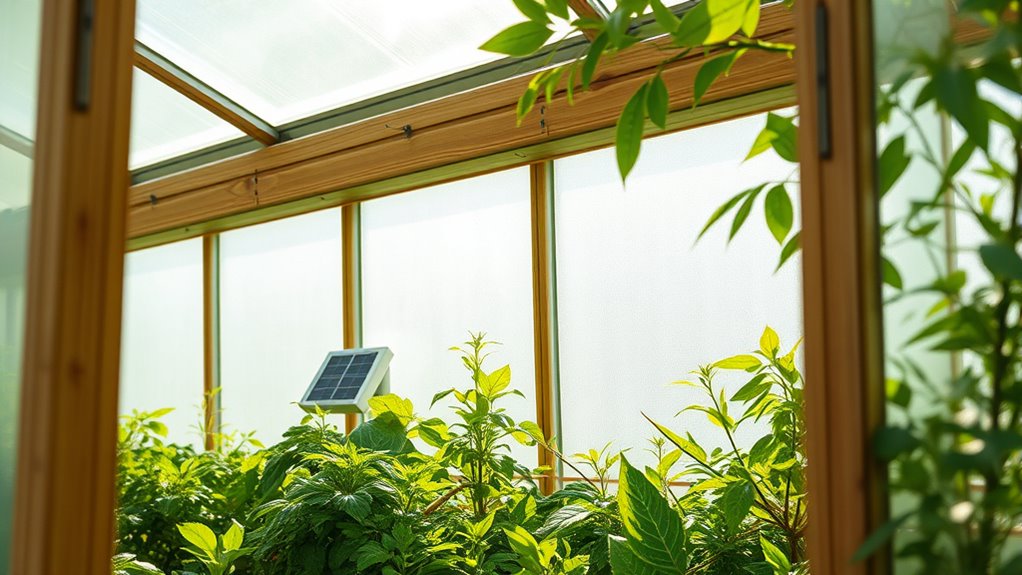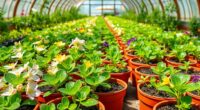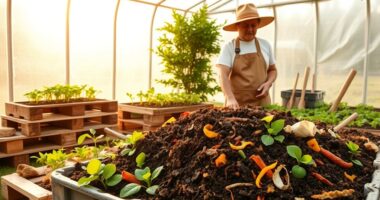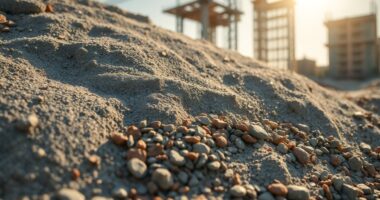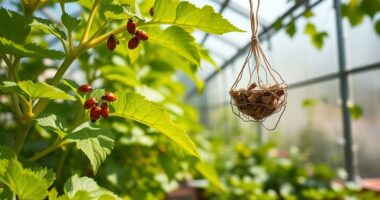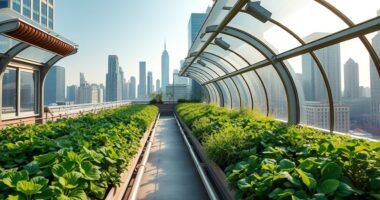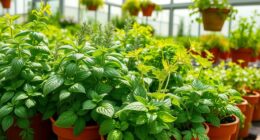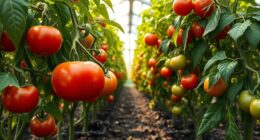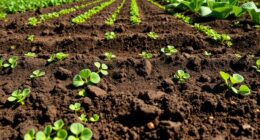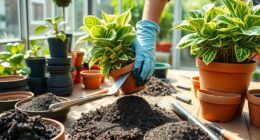To build an eco-friendly greenhouse, you can use recycled metals for the framework, sustainable wood or bamboo, and bio-based plastics that are recyclable or biodegradable. Incorporate natural insulation materials like wool, straw, cork, or bark to improve thermal efficiency. Opt for eco-conscious glazing options such as recycled glass or polycarbonate panels, and consider innovative composites that combine traditional materials with advanced, sustainable technologies. Keep exploring to discover how to make your greenhouse more environmentally friendly.
Key Takeaways
- Utilize recycled metals, sustainable wood, and bamboo for durable, eco-friendly greenhouse structural frameworks.
- Incorporate natural insulating materials like wool, straw, cork, and bark to enhance thermal efficiency sustainably.
- Use bio-based, recyclable plastics and biopolymers for lightweight, eco-conscious coverings and internal components.
- Opt for eco-friendly glazing materials such as recycled glass and polycarbonate panels to maximize light and energy efficiency.
- Integrate traditional and innovative green building composites to reduce environmental impact and promote sustainability.
Recycled Metals for Structural Frameworks
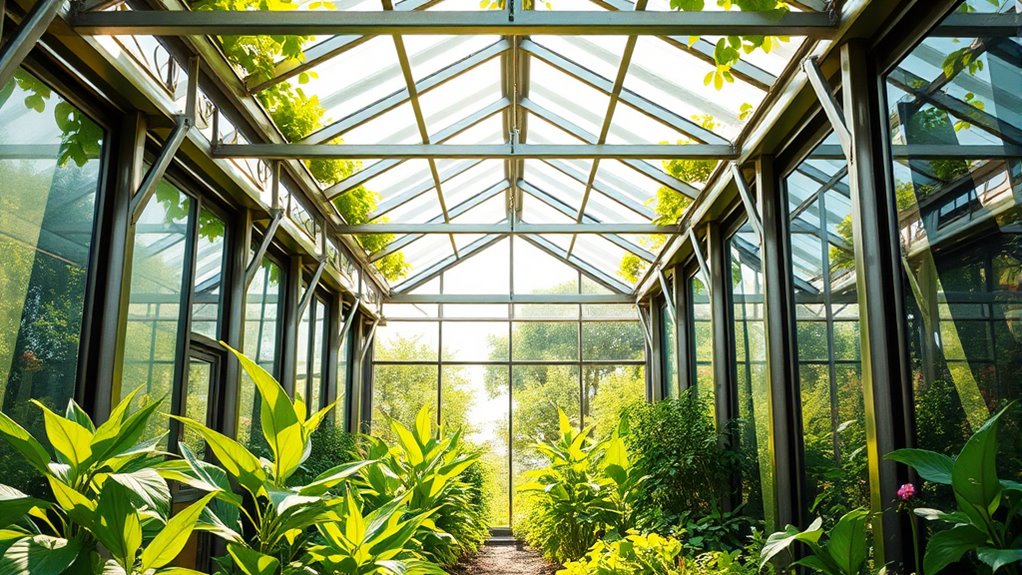
Recycled metals are increasingly popular for constructing the structural frameworks of eco-friendly greenhouses because they offer durability and sustainability. By prioritizing metal reuse, you can reduce waste and lessen your environmental footprint.
Recycled metals offer durable, sustainable options for eco-friendly greenhouse structures.
These recycled metals maintain strong structural integrity, ensuring your greenhouse remains stable and safe over time. Using repurposed steel or aluminum not only supports eco-conscious practices but also provides resilience against weathering and corrosion. Recycling practices can further enhance the eco-friendliness of your project by reducing energy consumption and carbon emissions associated with manufacturing new materials. Incorporating sustainable materials also encourages a circular economy, promoting resource efficiency and waste reduction. Additionally, selecting recycled metals can contribute to carbon footprint reduction, further supporting your environmental goals.
This choice minimizes the need for frequent repairs and replacements, making your project more cost-effective in the long run. Plus, recycled metals are readily available and easy to work with, allowing you to customize your greenhouse structure efficiently. Embracing metal reuse contributes considerably to building a sustainable, durable, and environmentally responsible greenhouse.
Sustainable Wood and Bamboo Options

Sustainable wood and bamboo are renewable resources that can considerably reduce your environmental impact. They offer impressive durability and strength, making them reliable choices for greenhouse structures. Additionally, sustainable harvesting practices support healthy ecosystems while meeting your building needs. Properly sourced bamboo and wood can also contribute to carbon sequestration, helping to mitigate climate change effects. Choosing locally sourced materials can further minimize transportation emissions and support regional economies. Moreover, selecting materials with recognized certifications and endorsements from beauty experts ensures their authenticity and quality. Emphasizing timber certification standards can help ensure that your materials are ethically sourced and environmentally responsible.
Renewable Resource Benefits
Choosing renewable resources like sustainable wood and bamboo can considerably reduce the environmental impact of greenhouse construction. These materials are abundant, fast-growing, and require less energy to harvest compared to traditional options. Freshly cut bamboo and wood naturally lend themselves to biodegradable pest control methods, reducing reliance on harmful chemicals. Using them supports eco-friendly practices, such as solar powered ventilation, which minimizes energy consumption. Additionally, bamboo and wood naturally lend themselves to biodegradable pest control methods, reducing reliance on harmful chemicals. Their renewable nature guarantees you’re making a sustainable choice that helps conserve resources for future generations. Incorporating renewable building materials can also enhance the overall durability and resilience of your greenhouse. Utilizing sustainable harvesting techniques ensures that these resources are replenished responsibly, maintaining ecological balance. Properly selecting sustainable materials contributes to a healthier environment while maintaining effective greenhouse functionality. This approach aligns with the goals of eco-conscious construction, proving that renewable resources offer practical benefits beyond sustainability, including compatibility with innovative, low-impact systems like solar-powered ventilation and biodegradable pest control.
Durability and Strength
While some may doubt their strength, sustainable wood and bamboo can provide remarkable durability for greenhouse construction. These materials withstand weathering and stress when properly treated, making them suitable for supporting structures and framing. Their natural resilience allows for seamless integration of solar panels, ensuring energy efficiency without compromising strength. Additionally, their sturdy composition supports water conservation systems, such as drip irrigation and rainwater harvesting setups. Proper installation techniques and adherence to best practices enhance material longevity significantly contribute to maintaining their structural integrity over time. Using appropriate fasteners and connectors can further improve stability and durability in various environmental conditions. To enhance durability, you can:
- Use natural preservatives or eco-friendly sealants
- Incorporate cross-laminated bamboo for added strength
- Regularly maintain and inspect joints and supports
With proper care, sustainable wood and bamboo offer long-lasting, eco-friendly options that meet structural demands while supporting your greenhouse’s sustainability goals.
Eco-Friendly Harvesting
Opting for eco-friendly harvesting methods guarantees that your greenhouse materials remain sustainable from the start. Using sustainably sourced wood and bamboo minimizes environmental impact while supporting responsible forestry practices. These materials often feature enhanced solar integration, improving energy efficiency, and promote water conservation by requiring less processing. To understand their benefits, consider this table:
| Material | Sustainability Feature | Eco-Friendly Benefit |
|---|---|---|
| Bamboo | Fast-growing, renewable | Reduces deforestation |
| Reclaimed Wood | Reuses existing resources | Low environmental footprint |
| Certified Wood | Sustainably harvested | Supports responsible forestry |
Choosing these options ensures your greenhouse remains environmentally friendly, helping conserve water and harness solar energy effectively. Sustainable harvesting methods further ensure the longevity and ecological soundness of your materials, especially when combined with responsible forestry practices. Incorporating AI-driven sustainability assessments can optimize resource use and further enhance your eco-friendly approach. Additionally, adopting environmentally conscious harvesting techniques can further reduce ecological impacts and promote biodiversity conservation. Recognizing the importance of sustainable forestry can lead to better resource management and long-term ecological benefits.
Bio-Based and Recyclable Plastics
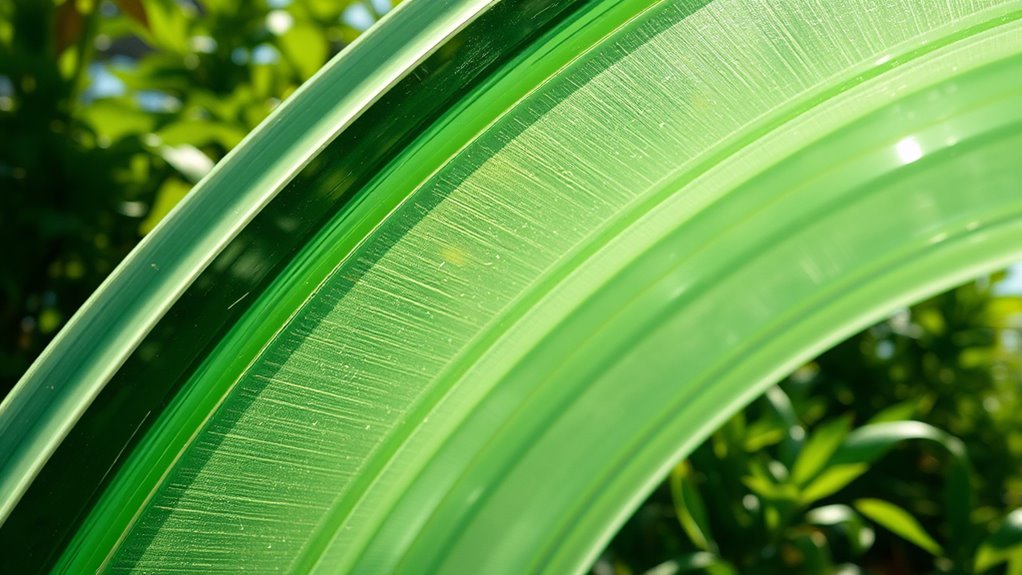
Have you considered how bio-based and recyclable plastics can transform greenhouse construction? These materials offer sustainable alternatives by reducing reliance on fossil fuels and promoting circular economies.
Biopolymer applications include using plant-based plastics that decompose naturally, minimizing environmental impact. Incorporating biodegradable additives enhances the breakdown process, ensuring plastics don’t persist in the environment.
Key advantages include:
- Reduced carbon footprint through renewable resources
- Enhanced durability while remaining eco-friendly
- Opportunities for customization with biodegradable additives
Insulating Materials From Natural Sources
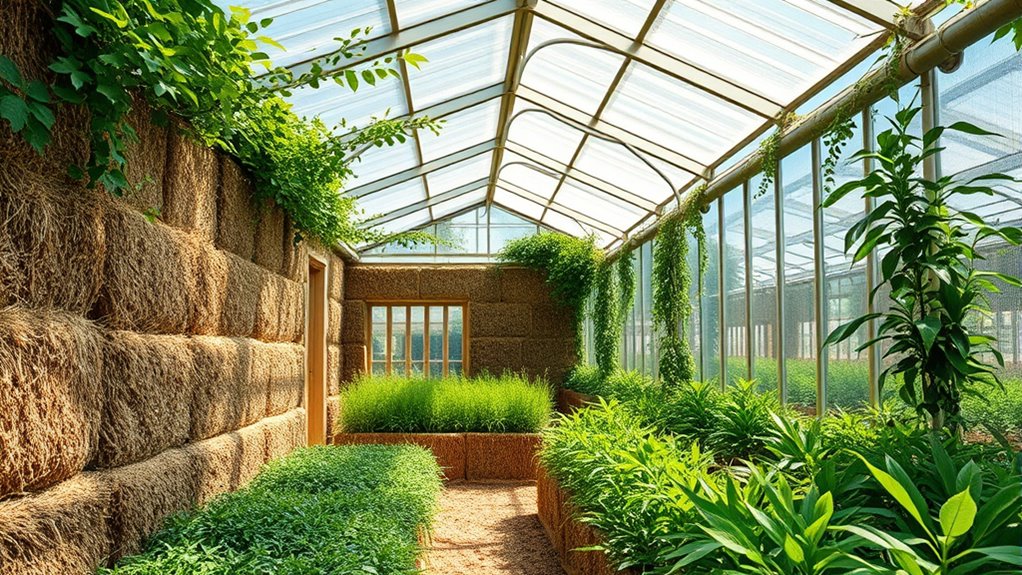
Natural insulating materials like wool and other fibers, straw and thatch, as well as cork and bark layers, offer sustainable options for your greenhouse. These materials help maintain ideal temperatures while reducing environmental impact.
Exploring their benefits can enhance both the efficiency and eco-friendliness of your construction.
Wool and Natural Fibers
Wool and other natural fibers serve as excellent insulating materials for eco-friendly greenhouses due to their high thermal efficiency and sustainable sourcing. Wool insulation, in particular, offers superior warmth retention and moisture regulation, making it ideal for maintaining optimal internal conditions.
Natural fiber textiles are renewable and biodegradable, reducing environmental impact. When considering wool and natural fibers, keep in mind:
- Their excellent thermal insulation properties, which help decrease energy use
- Their natural ability to absorb and release moisture, promoting a healthy environment
- Their durability and resistance to pests, ensuring longevity in greenhouse applications
Using these materials supports eco-conscious construction while enhancing greenhouse performance. Wool insulation and natural fiber textiles stand out as sustainable, effective options for maintaining temperature and humidity, contributing to greener, more efficient farming spaces.
Straw and Thatch Insulation
Building on the benefits of natural fibers like wool, straw and thatch offer renewable, biodegradable options for insulating greenhouses. Straw and thatch are effective insulators when applied using traditional thatching techniques or straw bale construction. They help regulate temperature, reduce energy use, and promote sustainability. Straw bales, stacked and sealed properly, create a solid insulating layer, while thatch adds a breathable barrier that maintains humidity. These materials are affordable, locally sourced, and easy to install. Here’s a visual overview:
| Material | Application Method | Benefits |
|---|---|---|
| Straw Bale | Construction, insulation | High insulation, eco-friendly |
| Thatch | Traditional thatching | Breathability, insulation |
| Both | Combined or separate | Cost-effective, renewable |
Using straw and thatch aligns with eco-friendly goals and traditional techniques.
Cork and Bark Layers
Cork and bark layers serve as excellent insulating materials derived directly from renewable resources. They provide effective thermal regulation while supporting eco-friendly practices. These materials naturally offer biodegradable finishes, reducing environmental impact over time.
Additionally, cork and bark act as natural pest barriers, helping to keep unwanted insects out without chemical treatments. Their porous structure also enhances moisture regulation, creating stable conditions inside your greenhouse.
When using cork or bark, consider their versatility for various applications, from wall insulation to mulching. You benefit from their sustainable sourcing, which promotes responsible harvesting without harming trees.
Incorporating these natural insulators helps create a greener, healthier environment for your plants and reduces reliance on synthetic materials. Ultimately, cork and bark layers contribute to a sustainable, efficient, and eco-conscious greenhouse design.
Eco-Friendly Glazing and Coverings
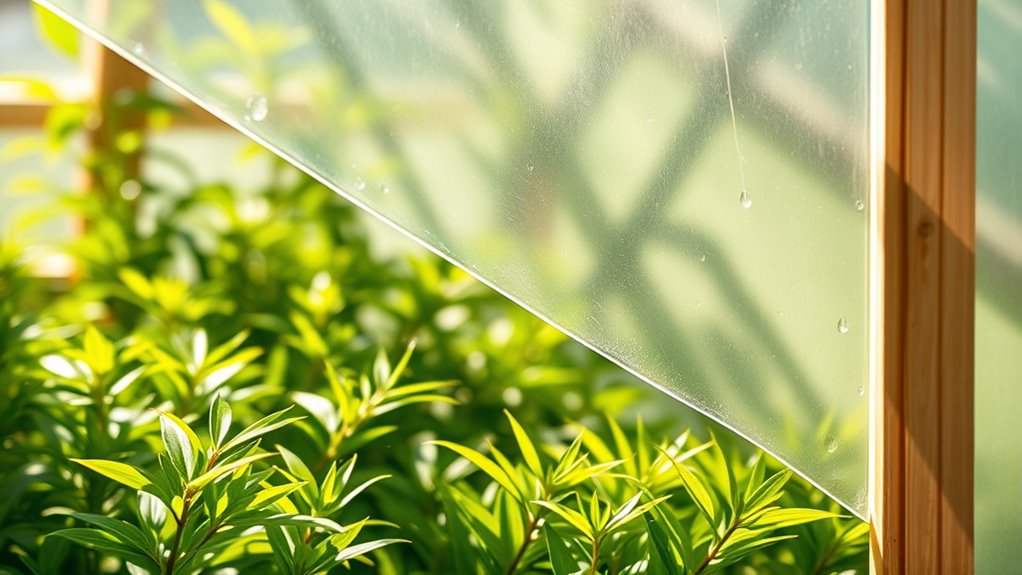
Eco-friendly glazing and coverings play a crucial role in creating sustainable greenhouses by maximizing light transmission while minimizing environmental impact. They harness solar energy effectively, ensuring plants receive ample sunlight for growth without excessive energy use.
Using recyclable or biodegradable materials reduces waste, supporting water conservation by preventing leaks and runoff. These coverings often feature coatings that improve insulation, reducing the need for heating and cooling, which conserves water and energy.
Polycarbonate panels and recycled glass are popular choices because they’re durable, lightweight, and eco-friendly. By selecting these materials, you enhance your greenhouse’s efficiency and reduce its carbon footprint.
Eco-friendly glazing not only benefits your plants but also aligns with sustainable practices, making your greenhouse more environmentally responsible and cost-effective.
Innovative Green Building Composites

Innovative green building composites are transforming sustainable construction by combining traditional materials with advanced technologies. These composites enable you to enhance energy efficiency, incorporate solar integration, and improve water conservation efforts.
Green building composites combine traditional materials with advanced tech to boost sustainability and efficiency.
By blending recycled materials with bio-based binders, you get sustainable solutions that reduce environmental impact. These composites also support:
- Enhanced thermal insulation for better energy savings
- Integration of solar panels directly into building components
- Water-repellent features that minimize water usage and runoff
This approach helps you create structures that are both eco-friendly and cost-effective.
As you adopt these advanced materials, you’ll contribute to lowering carbon footprints and conserving essential resources. Embracing innovative composites empowers your projects to meet modern sustainability standards while maintaining durability and aesthetic appeal.
Frequently Asked Questions
How Do Eco-Friendly Materials Impact Greenhouse Climate Regulation?
You might wonder how materials influence greenhouse climate regulation. Eco-friendly options, like those with good thermal insulation, help maintain stable temperatures, reducing energy use.
They also support moisture regulation, preventing excess humidity or dryness that could harm plants.
Are There Cost Differences Between Traditional and Green Construction Materials?
Imagine building a sturdy house with bricks that cost more but last longer and save energy.
When comparing traditional and green materials, you’ll find that material costs for eco-friendly options can be higher upfront, impacting your budget.
However, over time, these sustainable choices may reduce operating expenses.
What Are the Long-Term Durability Considerations of Eco-Friendly Materials?
When considering long-term durability, you should evaluate the material lifespan and maintenance requirements.
Eco-friendly materials often have comparable or even longer lifespans than traditional options, but some may need more regular upkeep to prevent degradation.
By choosing sustainable options with proven durability, you guarantee your greenhouse remains resilient over time.
Regular maintenance helps extend the lifespan, making eco-friendly choices a smart investment for long-term performance.
How Do Green Materials Influence the Overall Energy Efficiency of a Greenhouse?
Think of green materials like a cozy blanket for your greenhouse. They enhance energy efficiency by improving solar insulation and thermal regulation, keeping temperatures stable and reducing energy waste.
By using eco-friendly materials, you’ll lower your carbon footprint while maintaining ideal growing conditions. This sustainable approach helps your greenhouse stay energy-efficient long-term, saving you money and supporting environmental health.
Ultimately, green materials make your greenhouse both eco-conscious and cost-effective.
Are Eco-Friendly Materials Suitable for All Climate Zones and Environments?
You might wonder if eco-friendly materials fit every climate zone. The answer depends on their climate adaptability and material versatility.
Some eco-friendly options, like recycled metals or bamboo, perform well in various environments, but others may need extra insulation or protection.
Conclusion
By choosing eco-friendly materials for your greenhouse, you’re not just building a structure—you’re supporting sustainability and reducing environmental impact. Recycled metals, sustainable wood, bio-based plastics, natural insulations, and innovative composites all play a crucial role. Are you ready to make a positive difference with your project? Embracing these materials not only benefits the planet but also creates a healthier, more resilient environment for your plants and future generations.
